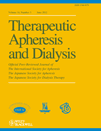
THERAPEUTIC APHERESIS AND DIALYSIS
Scope & Guideline
Advancing the frontiers of hematology and nephrology.
Introduction
Aims and Scopes
- Therapeutic Apheresis:
The journal emphasizes the role of therapeutic apheresis in treating various medical conditions, including autoimmune disorders, hematological diseases, and complications arising from chronic kidney disease. It includes studies on the efficacy and safety of procedures such as plasma exchange and leukapheresis. - Dialysis Modalities:
Research on different dialysis modalities, including hemodialysis and peritoneal dialysis, is a core focus. The journal covers topics related to the optimization of dialysis techniques, patient management, and long-term outcomes of dialysis therapies. - Innovative Treatment Approaches:
The journal highlights innovative treatment approaches, such as the use of machine learning in predicting patient outcomes, novel dialysis membranes, and blood purification technologies. This includes advancements in therapeutic devices and their clinical applications. - Patient-Centered Care:
Studies focusing on patient-centered care, quality of life, and psychosocial aspects of treatment in patients undergoing dialysis and apheresis are integral. This includes research on patient education, adherence to treatment, and shared decision-making. - Epidemiology and Outcomes:
The journal publishes epidemiological studies that assess patient populations undergoing dialysis and apheresis, detailing outcomes related to mortality, morbidity, and complications associated with these therapies.
Trending and Emerging
- Machine Learning and Predictive Analytics:
There is a growing trend towards utilizing machine learning and predictive analytics in the management of dialysis and apheresis patients. This includes developing models to predict outcomes such as mortality and treatment response, indicating a shift towards data-driven decision-making. - Patient Quality of Life and Psychosocial Factors:
Recent publications have increasingly focused on the quality of life, mental health, and psychosocial factors affecting patients undergoing dialysis and apheresis. This trend highlights the importance of holistic care in managing chronic kidney disease. - Advanced Dialysis Technologies:
Emerging technologies, such as medium-cut-off dialyzers and innovative blood purification methods, are gaining traction in the literature. Research into these advanced modalities aims to improve patient outcomes and reduce complications. - COVID-19 Impact Studies:
The ongoing impact of COVID-19 on patients undergoing dialysis and apheresis has led to a surge in related research. Studies addressing infection rates, vaccine responses, and management strategies during the pandemic have become increasingly relevant. - Nutritional Interventions:
An increasing number of studies are focusing on nutritional interventions and their effects on patients undergoing dialysis. This emerging theme explores the links between nutrition, inflammation, and overall health outcomes in this population.
Declining or Waning
- Basic Science Research:
There has been a noticeable decline in basic science research related to the mechanisms of apheresis and dialysis. As clinical applications and outcomes take precedence, foundational studies seem to be less frequently published. - Traditional Dialysis Techniques:
Research focusing solely on traditional dialysis techniques without innovation or comparative analysis appears to be waning. As newer technologies and methodologies are developed, studies on conventional approaches are becoming less prominent. - Apheresis in Non-Renal Diseases:
The exploration of apheresis applications in non-renal diseases has decreased. While apheresis remains relevant for renal conditions, its use in broader medical contexts appears less frequently discussed in recent publications. - Longitudinal Studies:
Longitudinal studies that track outcomes over extended periods have become less common. This may reflect a shift towards more immediate, short-term studies that provide quicker results and insights. - Economic Evaluations:
Research focusing on the economic aspects of apheresis and dialysis, including cost-effectiveness analyses, seems to be less represented. As funding and resources shift, this area may be receiving less attention.
Similar Journals

KIDNEY & BLOOD PRESSURE RESEARCH
Transforming Knowledge into Clinical Practice.Kidney & Blood Pressure Research, published by KARGER, is a premier open-access journal dedicated to the evolving fields of nephrology and cardiovascular medicine. Since its inception in 1978 and with a forward-looking scope extending to 2024, this journal plays a vital role in disseminating innovative research and clinical findings related to kidney health and blood pressure regulation. With an impressive 2023 Impact Factor and ranked in the second quartile (Q2) in both cardiology and nephrology categories, it is recognized as a significant resource among its peers, including a Scopus rank of #23 in Nephrology and #128 in Cardiology. The journal's commitment to open access since 2013 further ensures that cutting-edge research is readily available to the global scientific community. Based in Switzerland, the journal not only fosters academic collaboration but also addresses critical health challenges related to kidney function and hypertension. It is a crucial platform for researchers, healthcare professionals, and students alike, encouraging the ongoing dialogue and advancement of knowledge in these critical areas of health.
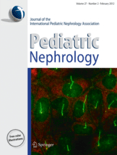
PEDIATRIC NEPHROLOGY
Innovating treatments to enhance the lives of young patients.Pediatric Nephrology, published by Springer, is a leading international journal dedicated to advancing the field of pediatric nephrology and enhancing the health of children with renal disorders. With its ISSN 0931-041X and E-ISSN 1432-198X, this esteemed journal has been in circulation since 1987 and has established itself as a vital resource for researchers and clinicians alike. Featuring a robust impact factor and categorized in Q1 for Pediatrics, Perinatology and Child Health, and Q2 for Nephrology, Pediatric Nephrology stands at the forefront of medical literature, reflecting its commitment to disseminating high-quality research. The journal is particularly noted for its comprehensive scope, encompassing clinical studies, innovative treatments, and cutting-edge research findings that shape pediatric kidney care. Located in Germany and reaching a global audience, this journal not only supports the academic community but also plays a crucial role in improving health outcomes for children worldwide. Access to its valuable content is essential for any practitioner or researcher invested in the evolving landscape of pediatric medicine.

NEPHROLOGY DIALYSIS TRANSPLANTATION
Fostering excellence in nephrology and transplantation research.NEPHROLOGY DIALYSIS TRANSPLANTATION is a premier academic journal published by Oxford University Press that plays a vital role in disseminating cutting-edge research within the fields of nephrology and transplantation. With an impressive impact factor and recognition as Q1 in both these categories for 2023, the journal ranks among the top publications in medicine, enhancing its visibility among a global audience of researchers, healthcare professionals, and students. Established in 1986, the journal has maintained a commitment to publishing high-quality, peer-reviewed articles that contribute to the advancement of knowledge and practice in renal medicine. Although this journal does not offer open access options, it remains a highly regarded resource due to its rigorous selection process and influential contributions to the field. Scholars are encouraged to explore the journal’s extensive archive, spanning from 1986 to 2024, for invaluable insights and developments in nephrology and transplantation.
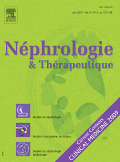
Nephrologie & Therapeutique
Fostering dialogue for a healthier future in nephrology.Nephrologie & Therapeutique is a distinguished peer-reviewed journal published by JOHN LIBBEY EUROTEXT LTD, dedicated to the field of nephrology. Since its inception in 2005, this journal has been pivotal in disseminating high-quality research in the areas of kidney disease, renal therapies, and nephrological advancements, and it continues to serve as an essential resource for professionals, researchers, and students alike. With an ISSN of 1769-7255 and an E-ISSN of 1872-9177, the journal is indexed in Scopus and is currently ranked in the third quartile (Q3) within the nephrology category, showing significant contributions to the discipline, despite its current ranking of 64 out of 81. Although Nephrologie & Therapeutique does not operate under an open access model, it nevertheless provides valuable insights and updates on the latest findings and practices in nephrology, making it an important platform for academic discourse in this field. The journal's commitment to advancing knowledge and fostering interdisciplinary dialogue underscores its role as a key player in shaping future research and clinical practices in nephrology.

Turkish Journal of Nephrology
Fostering knowledge exchange in nephrology and surgery.Turkish Journal of Nephrology, published by AVES, serves as a pivotal platform for disseminating significant research in the domains of nephrology, transplantation, and surgery. Since its establishment as an Open Access journal in 2019, it has gained traction for delivering high-quality, peer-reviewed articles that reflect the latest advancements and practices in these critical medical fields. Based in Turkey, this journal has rapidly become an important resource, particularly for researchers and healthcare professionals striving to enhance kidney healthcare strategies. Despite being categorized in the fourth quartile across its main categories for 2023 and having modest rankings within Scopus, its commitment to openness and accessibility fosters a collaborative academic environment that promotes knowledge sharing. We encourage scholars, practitioners, and students to engage with the journal's content to further drive innovation and improve patient outcomes in nephrology and associated disciplines.

International Journal of Nephrology
Advancing kidney research for a healthier tomorrow.The International Journal of Nephrology is a premier peer-reviewed journal published by HINDAWI LTD, dedicated to advancing the field of nephrology through the dissemination of high-quality research. With an ISSN of 2090-214X and an E-ISSN of 2090-2158, this open-access journal has been providing a platform for scholarly articles since 2010, ensuring that both researchers and practitioners have immediate access to the latest findings in kidney health and disease. As of 2023, it holds a reputable Q2 rating in the nephrology category, ranking 36th out of 81 journals in Scopus, placing it in the 56th percentile. The journal aims to foster innovation and collaboration within the nephrology community by covering a broad scope of topics, including clinical and experimental research, innovative treatments, and public health initiatives related to kidney disorders. Situated in the United States, the International Journal of Nephrology is committed to enhancing understanding and improving outcomes in nephrology by bridging academia with clinical practice, making it an essential resource for academics, clinicians, and students alike.
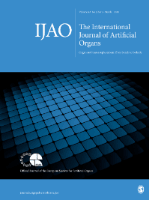
INTERNATIONAL JOURNAL OF ARTIFICIAL ORGANS
Unveiling New Horizons in Biomedical Engineering.International Journal of Artificial Organs is a prestigious peer-reviewed journal published by SAGE Publications Ltd, dedicated to advancing the field of bioengineering, biomaterials, and biomedical engineering. Established in 1978, the journal has a rich history of contributing to the research community with cutting-edge studies and advancements in artificial organ technology and related disciplines. With an impact factor that positions it in the Q3 category across multiple fields, including Medicine and Engineering, the journal serves as a vital resource for researchers, professionals, and students interested in innovative solutions for organ replacement and support. While it is not an open-access journal, it offers subscription-based access, ensuring the dissemination of high-quality research to stakeholders globally. Located in Italy, the journal’s scope encompasses a variety of disciplines, making it essential reading for those at the forefront of medical technology development. Explore the latest breakthroughs and join a community committed to transforming lives through science and engineering.

Kidney360
Redefining nephrology through open-access knowledge.Kidney360 (ISSN: 2641-7650) is a prominent open-access journal published by the American Society of Nephrology, dedicated to advancing the field of nephrology and its intersecting medical disciplines. Established with a vision to foster innovative research and promote a deeper understanding of kidney health, this journal is positioned as a vital resource for nephrologists, researchers, and healthcare professionals. With its classification in Q1 in Nephrology and Q2 in Medicine (miscellaneous) for 2023, Kidney360 ranks favorably, highlighting its commitment to publish high-quality, impactful research, recognized in the top percentile of its field. The journal's accessible platform aims to disseminate knowledge effectively, making it an essential repository for cutting-edge studies, reviews, and clinical research. By encouraging collaboration across various disciplines, Kidney360 plays a critical role in shaping the future of nephrology and enhancing patient care on a global scale.
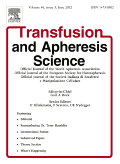
TRANSFUSION AND APHERESIS SCIENCE
Exploring Breakthroughs in Blood Science and Therapeutic StrategiesTRANSFUSION AND APHERESIS SCIENCE, published by Pergamon-Elsevier Science Ltd, serves as a pivotal platform for researchers and practitioners in the fields of hematology, transfusion medicine, and apheresis. With an ISSN of 1473-0502 and an E-ISSN of 1878-1683, this peer-reviewed journal boasts a respectable Q3 ranking in the Hematology category as of 2023, positioning it within the 45th percentile among its counterparts. Operating from the United Kingdom, it provides comprehensive insights into the latest advancements and methodologies in transfusion practices and apheresis technology, crucial for enhancing patient care and therapeutic strategies. The journal's scope, covering key developments from 1996 to 2024, allows for a deep exploration of historical and emerging trends within the discipline. Moreover, its open access options facilitate widespread dissemination of research findings, fostering collaboration and innovation in the scientific community. For those dedicated to advancing knowledge in hematology, TRANSFUSION AND APHERESIS SCIENCE represents an essential resource, bridging theory and practice in this vital area of healthcare.
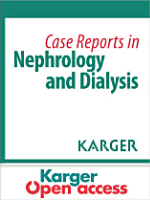
Case Reports in Nephrology and Dialysis
Advancing renal insights through shared experiences.Case Reports in Nephrology and Dialysis, published by KARGER, is a vital peer-reviewed journal dedicated to the dissemination of case reports and innovative findings in the fields of nephrology and dialysis. Since its inception in 2015, this Open Access journal has aimed to foster knowledge exchange and improve patient outcomes through comprehensive case studies, clinical insights, and recent advancements in renal healthcare. Based in Switzerland, the journal is poised to serve a global audience, accommodating research that spans diverse geographical and clinical contexts. Currently ranked in the Q3 category for nephrology in 2023, it underscores its burgeoning influence in the medical literature, despite its relatively nascent presence. As a valuable resource for researchers, healthcare professionals, and students, it provides a platform for sharing unique cases that enrich the understanding of complex renal issues and challenges faced in dialysis. With an emphasis on high-quality, accessible research, Case Reports in Nephrology and Dialysis is committed to advancing nephrology and dialysis practices through collaboration and knowledge sharing.